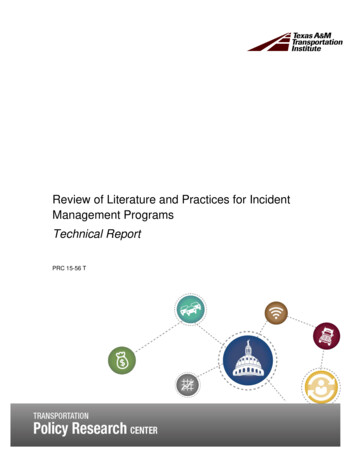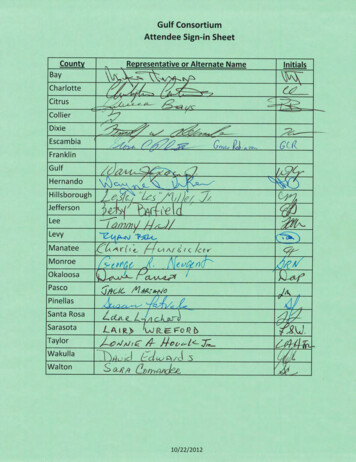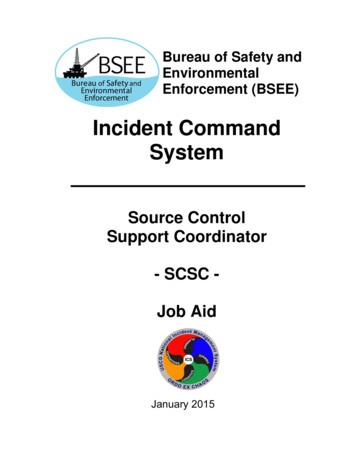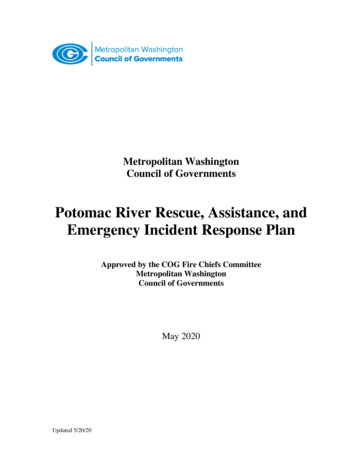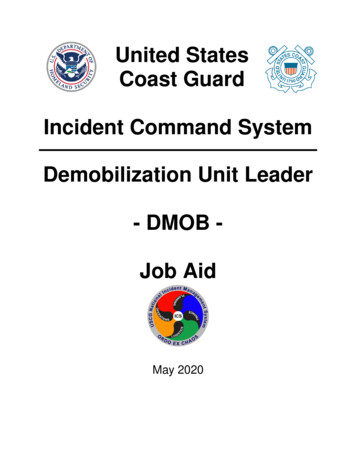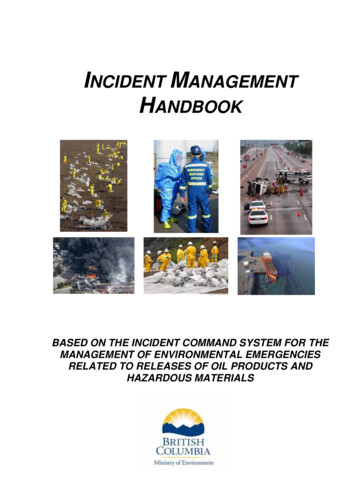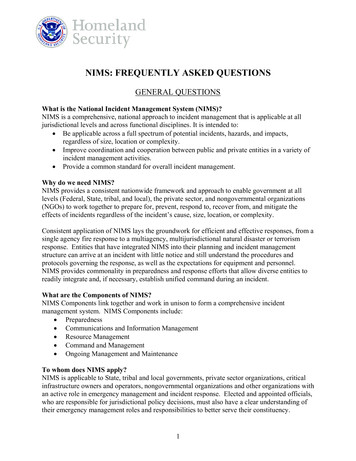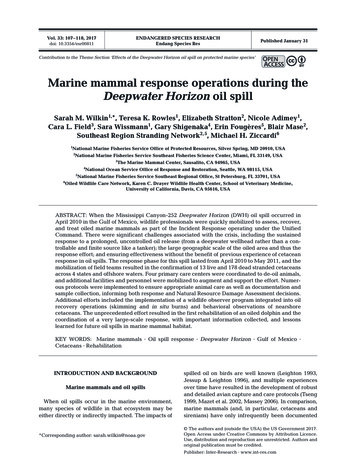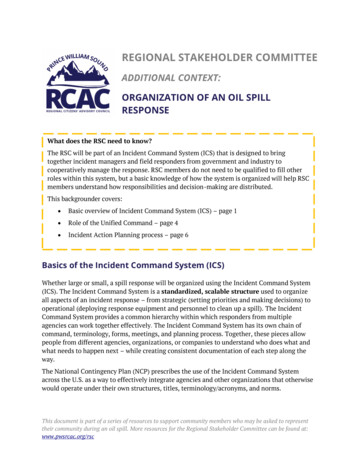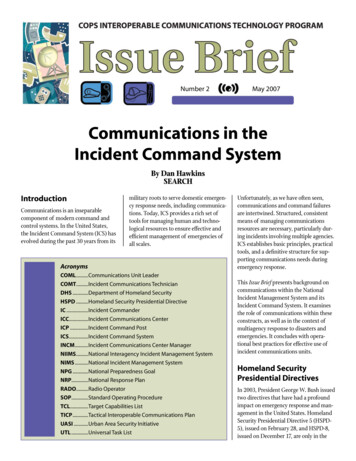
Transcription
Number 2May 2007Communications in theIncident Command SystemBy Dan HawkinsSEARCHIntroductionCommunications is an inseparablecomponent of modern command andcontrol systems. In the United States,the Incident Command System (ICS) hasevolved during the past 30 years from itsmilitary roots to serve domestic emergency response needs, including communications. Today, ICS provides a rich set oftools for managing human and technological resources to ensure effective andefficient management of emergencies ofall scales.AcronymsCOML.Communications Unit LeaderCOMT.Incident Communications TechnicianDHS.Department of Homeland SecurityHSPD.Homeland Security Presidential DirectiveIC.Incident CommanderICC.Incident Communications CenterICP.Incident Command PostICS.Incident Command SystemINCM.Incident Communications Center ManagerNIIMS.National Interagency Incident Management SystemNIMS.National Incident Management SystemNPG.National Preparedness GoalNRP.National Response PlanRADO.Radio OperatorSOP.Standard Operating ProcedureTCL.Target Capabilities ListTICP.Tactical Interoperable Communications PlanUASI.Urban Area Security InitiativeUTL.Universal Task ListUnfortunately, as we have often seen,communications and command failuresare intertwined. Structured, consistentmeans of managing communicationsresources are necessary, particularly during incidents involving multiple agencies.ICS establishes basic principles, practicaltools, and a definitive structure for supporting communications needs duringemergency response.This Issue Brief presents background oncommunications within the NationalIncident Management System and itsIncident Command System. It examinesthe role of communications within theseconstructs, as well as in the context ofmultiagency response to disasters andemergencies. It concludes with operational best practices for effective use ofincident communications units.Homeland SecurityPresidential DirectivesIn 2003, President George W. Bush issuedtwo directives that have had a profoundimpact on emergency response and management in the United States. HomelandSecurity Presidential Directive 5 (HSPD5), issued on February 28, and HSPD-8,issued on December 17, are only in the
beginning phases of implementation bylocal, state, tribal, and federal governments.HSPD-5HSPD-5, “Management of DomesticIncidents,” established a single, comprehensive National Incident Management System (NIMS), to be developedand administered by the Department ofHomeland Security (DHS) for use by alllevels of government.1 It noted that forpurposes of interoperability and compatibility,“NIMS [would] include a core set ofconcepts, principles, terminology, andtechnologies covering the incidentcommand system; multi-agency coordination systems; unified command;training; identification and management of resources (including systemsfor classifying types of resources);qualifications and certification; andthe collection, tracking, and reportingof incident information and incidentresources.”2HSPD-5 also required the Secretary ofDHS to develop, submit for approval,and administer a National ResponsePlan (NRP) that would use NIMS for theprovision of federal support to state andlocal agencies during domestic incidents.It required the adoption and use of NIMSby federal agencies in support of stateand local government during domesticincidents and established federal FiscalYear 20053 as the beginning of requirements for NIMS adoption by state andlocal agencies receiving federal preparedness assistance. It also required development of standards and guidelines forassessing that adoption.HSPD-8HSPD-8, “National Preparedness,”provided further definition of requirements that would affect agencies receiving federal assistance.4 Its purpose is tostrengthen preparedness capabilitiesof all levels of government to terrorist attacks, major disasters, and otheremergencies. It required development ofa National Preparedness Goal (NPG)5that includes readiness metrics, as well asfull implementation of a closely coordinated interagency grant process forfirst responder preparedness assistanceby the end of federal Fiscal Year 2005.The directive notes that, “[t]o the extentpermitted by law, Federal preparednessassistance will be predicated on adoptionof Statewide comprehensive all-hazardspreparedness strategies.”Three of the seven national prioritiesarticulated in the NPG are particularlyrelevant to the communications aspect ofemergency response: Implementation of a NIMS2 Ibid.3 October 1, 2004–September 30, 2005. to identify tasks from the UTL that theirorganizations need to perform based ontheir assigned roles and mission. The TCLdescriptions are used to determine thecapabilities needed to accomplish thesetasks.Currently, there are 36 capabilities inthe TCL, of which 32 are grouped intofour mission areas: prevent, protect,respond, and recover. The remaining four are capabilities common to allmission areas. Interoperable communications is second among the four common Strengthening of information-sharingand collaboration capabilities Strengthening communicationsinteroperability.The NPG relies on an approach calledCapabilities-Based Planning to reachthe goal. The approach uses 15 standardized National Planning Scenarios, aUniversal Task List (UTL) to referencetasks performed by all levels of government and different disciplines duringincidents, and a Target Capabilities List(TCL) that identifies capabilities neededto perform the tasks.The National Response Plan provides aconcept of operations with which state1 See 030228-9.html.and local emergency operations plans areintended to be aligned. Emergency operations plans are supported by or built onstandard operating procedures (SOP)that are intended to be consistent withNIMS guidelines, standards, and protocols. Emergency planners are expected4 See 031217-6.html.5 See .capabilities.6 Adoption and incorporationof NIMS and the capabilities listed onthe TCL will lead to advanced interagencycommunications that support commonresponse processes.Specific information on the NationalResponse Plan tasks and capabilities canbe found in the DHS Lessons LearnedInformation Sharing web site.76 The other three are planning, citizen preparedness and participation, and risk management.7 The Lessons Learned Information Sharing website is available only to emergency responseproviders and homeland security officials. Registration is required and eligibility is verified. Seehttps://www.llis.dhs.gov.Communications in the Incident Command System
Effects of HSPD-5 and -8on Local AgenciesThe federal government has been mostsignificantly affected by these presidentialdirectives. Local government, however,is recognized as the provider of the vastmajority of first response capabilities inthe United States. As reliance on federalfunding of local first response has grownsince the events of September 11, 2001,local agencies have become subject to thepresidential directives.One intent and effect of the HSPDs wasto standardize the mechanisms by whichgovernment agencies work togetherduring emergency incidents. As directed,preparedness assistance grant programshave become closely coordinated withimplementation of the NRP, adoption ofNIMS, and realization of target capabilities. Work is underway by committees ofpractitioners working through DHS todefine conditions and standards for eachtask, as well as performance measuresand metrics to assess capabilities.In federal Fiscal Year 2005, the DHSlinked its grant programs to completionof Tactical Interoperable Communications Plans (TICP). Each regionreceiving Urban Area Security Initiative(UASI) funding was required to completea TICP, as were designated metropolitanareas in states without UASI regions. Theplans were due by May 1, 2006, to befollowed by exercises within the jurisdictions validating the plan within a broaderhomeland security exercise and evaluation program.Principles of NIMS ICSNational Incident ManagementSystemIn March 2004, DHS introduced NIMS.It is, first and foremost, a common setof concepts, principles, terminology,and technology to improve emergencyresponse. It also provides standardresource, organizational, and operationaldefinitions. One key NIMS componentis an Incident Command System (ICS)familiar to many first responders acrossthe country.The NIMS ICS is built from 30 years ofexperience with large-scale emergencies.Based on military models, early incidentCommunications in the Incident Command Systemcommand systems emerged in the publicsafety world through efforts of Californiafirefighting and emergency management agencies to deal with devastatingwildfires. These systems broadened andevolved over the years to now serve inemergencies and disasters of all types.
NIMS ICS evolved primarily from theearlier National Interagency IncidentManagement System (NIIMS), a systembroadly adopted previously by local,state, tribal, and federal agencies. It is theNIMS command and management subsystem designed to provide effective andefficient tools for emergency response.Today, NIMS ICS use is a requirement offederal funding for agencies in domesticemergency response.ICS Principles andCommunicationsNIMS ICS is based on 14 managementprinciples. Two are particularly notablewhen it comes to communicationsinteroperability. ICS is built on the following: Common terminology coveringorganizational structures, operationalresources, and facilities Integrated communications, including development and use of a common communications plan coveringprocesses and technology.n Common TerminologyThe importance of common terminologyis clear in interagency communications:responders cannot coordinate and co-Law Enforcement Tech Guide for Communications Interoperability: A Guide for Interagency CommunicationsProjects provides further information on NIMS in thecontext of interoperability. Produced by SEARCHunder COPS Office sponsorship, it is available from theCOPS Office Response Center, 800.421.6770, and RID 238.operate if they are unable to understandone another when they try to communicate. The need for common terminologyprecedes incident response, however.Preincident planning and coordinationrequire a common language to articulate needs, describe processes, establishpolicies, craft joint SOPs, and ultimatelycommand resources during interagencyoperations. Interagency communications SOPs require a common dialect fordescribing the “who, when, why, where,what, and how” of operations.ing principles generally embodied in ICS,such as management span of control.n Integrated CommunicationsCommunications in the ICSStructureUnder ICS, communications and incidentaction plans have to be integrated tocapture management goals and operational objectives. Integration of supporting services and technologies is criticalto effective incident response. Sinceresponder safety and effectiveness areclosely related to how well communications supports them, the capabilities andcapacity of systems to support operationsis taken into account continuously duringincident action planning.Communications is integrated into ICSbased management systems by the earlyestablishment of a communications unitduring incidents and involvement of theCommunications Unit Leader in incidentaction planning. This is not only to ensure that the response is well supportedby communications, but also to reinforcechosen command structures and operat- Integrated communications: Ensures that incident managementgoals and objectives are captured Maximizes responder safety and accountability Is continuous throughout an incident Reinforces command structure andspan of control.The communications unit is oftenestablished early in multiagency andlarge-scale responses managed under ICSto support the integration effort. This isintended to bring all communicationsfunctions close to incident command,rather than having them managed farfrom pressing operational considerations.Structurally, the Communications Unitin NIMS ICS operates in the LogisticsSection, under the Service Branch. SeeFigure 1. It is managed by a unit leader,consistent with other NIMS positionnaming conventions. Dispatchers (radiooperators) and communications technicians serving the incident are also part ofthe unit.Communications in the Incident Command System
Figure 1: Location of the Communications Unit in an ICS OrganizationOperational Best PracticesHierarchical CommunicationsImplementation of multiagency incidentcommunications systems organized under ICS first demands a rigorous definition of operational plans far beyond communications. Many, if not most, cases ofinteragency communications failures areattributable to either poor command systems or a weak definition of interagencyoperational needs. Who needs to talk towhom, under what circumstances, mustbe defined well before communicationscan serve to enable their response.Whether communications occur by voiceover radio, data over fixed wires, or evenin person, there is great need in organizations—particularly those evolvingdramatically during the compressed timeframes of emergencies—to communicate“through channels.” From military roots,the ICS provides a hierarchical chain ofcommand that expands and contractsbased on the size and needs of incidents.Through this classical organization ofhuman functions, each person fulfillinga role has a clear route, if not means, ofcommunications up and down the chainof command.For example, even the common citizencan understand that having all responders on a single radio channel during anevent of any significant size would bechaos. Likewise, conducting command,operational, and logistics tasks on a singlechannel during a sizeable emergency is arecipe for disaster. Separate channels forindividual functions are crucial to maintaining command and control.ICS responders speak of the need to “talkup one and down one,” meaning thatthey need to talk up the command chainone slot to their supervisor and downone to everyone they supervise. Besidethe Incident Commander (IC), who isthe top-level supervisor from an incidentcommand perspective, and the lowestcrew member, who supervises no one,every other person in the command chainCommunications in the Incident Command Systemneeds to talk through channels up one anddown one.The common citizen probably does notrecognize how easily communicationschannels get overwhelmed or how difficult it is to sift out extraneous information during intense emergencies. Toomuch information can be as debilitating asnot enough.Often, the need for interagency communications arises because responseelements have not been combined into asingle operational unit, leading to a needfor more communications resources:yours, mine, and now ours. The age-oldapproach of patching each responder’schannel into one big party line oftencauses more problems than it solves.
The amount of traffic on each channel ispotentially multiplied by the number ofchannels being combined—just when internal communications needs skyrocket.The sheer volume of information andcontext-switching demanded during largeemergencies forces greater focus in communications, not simply more.Hierarchical communications ispart and parcel of the ICS. Theorganizational structure of anincident response that cannot bedrawn clearly cannot be servedadequately by communications.In effect, the lines betweenfunctions in an ICS organizationchart depict needed channels ofcommunications of some formor another. Multiple or circularpaths of command/communications in such a chart are clearindicators of where communications problems will occur. Thenotion of “one up, one down”is of much greater intent thanmerely how many radio channelsone person can manage.Communications ProceduresClearly, operational definition of requirements is necessary for communicationsto support needs during an actual response. It is impossible to build communications capabilities in preparation foror during emergencies without a detailed understanding of the responders’individual and organizational hierarchyneeds. Certain operational best practiceshave arisen and are offered in this IssueBrief for consideration. Communicationsprocedures, formalized position dutydescriptions, incident staffing recommendations, and a sample incident communications plan are provided.The following communications procedural practices have been widely adoptedin multihazard response systems. Theterm “channel” is used here in a genericsense to refer to any of a wide variety ofmeans of communicating from one pointto another using electrical or electromagnetic signals. Voice radio channels may bemost commonly assumed, although otherforms of communications are equallyapplicable.n Emergency TrafficHow is it announced? Who’s in charge?How is it cleared?Even during emergencies, a given radiotransmission may have a higher or lowerpriority over competing traffic for thechannel. The phrase “emergency traffic”is used to gain priority access to a unit’soperational or designated emergencychannel. The phrase is transmitted by theresponder in need, causing the channelcontroller—often a unit leader, dispatcher, or radio operator—to stop otheruse of the channel and defer to the calleruntil normal traffic can resume.n Channel Span ofControlHow many resources can be assigned?The optimum number of units on achannel is very dependent on their tasks.Some positions and tasks require very little access to radio channels, whileothers make heavy use of a single channel between team members and stakeresponder safety on access to it.Ideally, a single channel is assigned tosupport and enforce the standard ICSspan of control of one manager or supervisor over three to seven subordinates.That may be the operations section chiefcommunicating with three functionalgroup supervisors or a group supervisorcommunicating with five tactical teamleaders, for example.The most common response heard fromcommunications and incident managersfaced with the need to maintain a channelspan of control is that limited channelavailability prevents this from beingimplemented. The result is too manypeople on too few channels—and communications overload.A corollary is that responders using achannel can and do become overwhelmedby the amount of traffic on it, particularlyif the traffic isn’t immediately relevant totheir assignment. This leads to lost messages, contention between users, and—too often—responders turning down thevolume on their radios to focus attention.Anyone ever involved in a large-scaleemergency response with dozens ofresponders in a small area, each carryinga radio with busy channels, knows howdifficult communicating can become. Responders conditioned to rely on scanningmultiple radio channels during routineemergencies are most adversely affectedwhen the volume of communications inlarger incidents outstrips their ability toassimilate all the information and theirradio’s ability to prioritize incomingtransmissions.There is no easy answer to this dilemmaof too much communications for toofew channels. The most critical resourceshortage in this regard is for voice radiochannels, but it can and does occur withCommunications in the Incident Command System
other channels of communications, suchas data networks. Ultimately, there hasto be greater capacity or less demand oneway or another. As is regularly experienced, the alternative is to suffer theproverbial “commo problems.”Communications and incident managersmust look for opportunities to reduceradio traffic when channel availability isconstrained. This can be done procedurally and/or through adaptation of technical capabilities. In the former case, procedures can be implemented to reduce theamount of traffic contending for limitedchannel space. Greater communicationsdiscipline is needed as incidents grow insize, somewhat limiting raw demand forchannels. Similarly, teams of responders able to communicate directly amongthemselves, without resorting to radiotransmission, may have to do so in orderto release the channel for more pressingneeds. Delegated and dispersed decision-making reduces communicationsdemands as well.Technology itself also leads to overwhelmed channels of communications.In routine emergencies, respondersmay need access to channels that coverentire jurisdictions. As incidents growin size and the pace of activity increases,responders become responsible for fewer,more intense and focused tasks. In suchcases, their communications needs narrow in geographic scope, too.The solution is to simplify communications, where possible. Use of direct,simplex radio channels in tactical operations, for example, can release wide-area,repeated channels for more appropriateuse. Such localized use allows the channelto be reused elsewhere in the jurisdiction outside of the geographic range ofinterference between radios.n Standard LanguageCommon terminology, standard resourcedefinitions, naming conventions, plainlanguage.Much of what passes as poor communications is actually miscommunications.NIMS ICS and its predecessors identifyas its first management characteristic theuse of common terminology for organizational elements, position titles, resources,and facilities. One of the most importantpolicies that can be established for interagency communications is a commonterminology to be used by responders,further reinforced through procedures.In addition, standard resource definitions improve interoperability. From acommunications standpoint, it is criticalto have standard naming conventionsfor channels and other communicationsresources across jurisdictions. It is fairlycommon for agencies that work togetherto have common radio channels at theirdisposal that they are unaware of or thatare named so differently that nobodywould associate them. Some regions goso far as to establish not only standardnames for shared channels or talk groups,but also standard programmed positionsin the radios for interagency resources.Last, the most important languagepolicy that can be adopted to improveinteragency communications is the useof plain language—eliminating codesand jargon. This is a simple idea, butevery vocation and avocation has its ownterminology. When these diverge acrossagencies and disciplines, respondersdon’t communicate.n Communications-Order ModelPositive message acknowledgment andthe five-step process.We recommend the use of communica-Communications in the Incident Command System“Communications oftenbecomes the ‘fall guy’ fororganizational problems.An excessive number ofresponders attempting totalk to the IC (generallyall at once), compressedtime, getting behindand chasing the incidentproblem, playing ‘catch up,’and general operationalconfusion can quicklybeat up and overwhelmany incident commo plan/system. Any part of thesystem operating beyondtheir effective span ofcontrol (five to six) willalmost instantly developcommo problems. The wayto fix the commo problemis to fix the span-of-controlproblem, and (bingo!) thecommo settles down andbecomes normal.”— “Fire Command”Chief Alan Brunacini (ret.)Phoenix (Arizona)Fire Department
tions procedures that ensure that messages are received and comprehended.In its simplest form, the communications-order model—as practiced by manyemergency response agencies—occursbetween two individuals. It is initiatedwhen the intended receiver indicatesreadiness to receive a message. Themessage is transmitted and the receiverrestates the message to confirm that itwas understood. If correct, the originalsender confirms, completing the communications sequence.n Operational Unit ReportingWe recommend using a standardizedstatus reporting procedure for operational units. It provides basic information for command decision-making andresponder accountability, while makingefficient and effective use of communications channels.For example, an exchange between anincident command post and an outerperimeter security team would followthese five steps:The unit can prepare a quick report thatprovides its current position, progresswith its current task, a statement of anyresource or support needs, and a simplestatement accounting for personnelassigned to the person preparing thereport. Such a personnel accountabilityreport provides a positive acknowledgment that the unit is intact and safe.1. “Front Street Road Block, this isCommand Post.”Communications Positions2. “Command Post, Front Street RoadBlock.”3. “Allow the Centerville Tactical Teamthrough and direct it to River RoadStaging.”4. “Centerville Tactical Team to River RoadStaging.”5. “Affirmative.”munications Unit Leader, IncidentCommunications Technician, IncidentCommunications Center Manager, andRadio Operator. Task books charting theduties of each position were created byNWCG and are available online.8n Communications Unit Leader(COML)The Communications Unit Leader,commonly referred to by the positionacronym COML, has a host of duties.Broadly, they include the following: Prepare the Incident CommunicationsPlan Establish and manage the IncidentCommunications Center (ICC) Manage personnel within the unitA second set of operational best practicescan be drawn from accepted responsibilities for standard ICS communicationspositions. As previously noted, theNational Interagency Incident Management System, or NIIMS, was the primaryprecursor to NIMS. The position management system developed for NIIMS by theNational Wildfire Coordinating Group(NWCG) provides the bulk of formal ICSposition descriptions available today.Four positions have been defined withinthe ICS Communications Unit: the Com- Manage communications equipmentassigned to the incident Establish communications capabilitiesand logical radio nets Provide any required off-incident communications links Participate in incident action planning.The COML position is often staffed earlyin ICS-based response systems. It is oneof the few noncommand or general staffpositions involved in incident actionplanning. It bears the responsibility ofintegrating communications—that is, ofensuring that operations are supportedby communications by directly participating with incident management.The COML must understand ICS andlocal response systems well enough to bea contributing “noncommissioned” member of the command team. This typicallyrequires someone with broad technical,managerial, and operational skills, not tomention problem-solving abilities.8 See c.htm. Communications in the Incident Command System
The position is responsible for developingthe Incident Communications Plan (ICSForm 205) and establishing the ICC. TheCommunications Plan is traditionallya key part of the Incident Action Plan,itself the central document in emergencyresponse organized under ICS. TheCOML is responsible for submitting anup-to-date Communications Plan forinclusion in each rendition of the Incident Action Plan, which may be updatedduring each operational period—oftentwice daily.The ICC is primarily a point of dispatchand secondarily a depot for equipmentand repairs. During larger incidents,it serves as the junction between traditional, standard dispatch centers andthe on-scene responders. It generally iscollocated with command and planningfunctions to create the Incident Command Post (ICP). The CommunicationsUnit Leader manages staff, facilities, andother resources assigned to the ICC.n Incident CommunicationsTechnician (COMT)Incidents involving more than a fewagencies and extending over more than aday or two often require communicationstechnician skills. The Incident Communications Technician is needed to deployadvanced equipment and keep it operational.n Incident CommunicationsCenter Manager (INCM)The Incident Communications Center Manager position is filled whenthe COML’s span of control would beexceeded either by the complexity of theincident, requiring an unusual degree ofinvolvement in incident action planning,or by the number of technicians andradio operators assigned to the unit. TheINCM serves primarily to supervise radiooperators and manage the increased complexity of an ICC during large incidents.n Radio Operator (RADO)Radio Operators may either serve asdispatchers or in assignment to incidentcommand or general staff. In the past,RADOs were often pulled from the ranksof on-scene responders and, with littletraining, were put to work in a commandpost during incidents. In recent years,however, tactical dispatch teams developed from professional 9-1-1 center staffhave become more common.Incident Dispatch ResourcesAt least two organizations exist for the benefit of incident dispatch. TheCalifornia Tactical Dispatcher Association is focused primarily on policeoperations: http://www.tacticaldispatch.com/.Communications Unit StaffingUnder the ICS, standard resource-typedefinitions are used to distinguish thevaried capabilities of different classes ofresources. Type I resources—whether individual or team—are the most capable,while Type IV resources are the leastcapable.The following chart depicts a sample resource typing for communications units.It shows how staff numbers and capabilities, equipment, availability, and management capability are used to classifyresources. This may be done to prequalifyteams before they are dispatched in support of an incident or simply to standardize definitions for classifying existingresources within a region.Communications Unit staffing needs varyaccording to the scope and scale of theincident. More Radio Operators and Incident Communications Technicians areneeded as more agencies and respondersare involved. Multi
National Incident Management System In March 2004, DHS introduced NIMS. It is, first and foremost, a common set of concepts, principles, terminology, and technology to improve emergency response. It also provides standard resource, organizational, and operational definitions. One key NIMS component is an Incident Command System (ICS)


